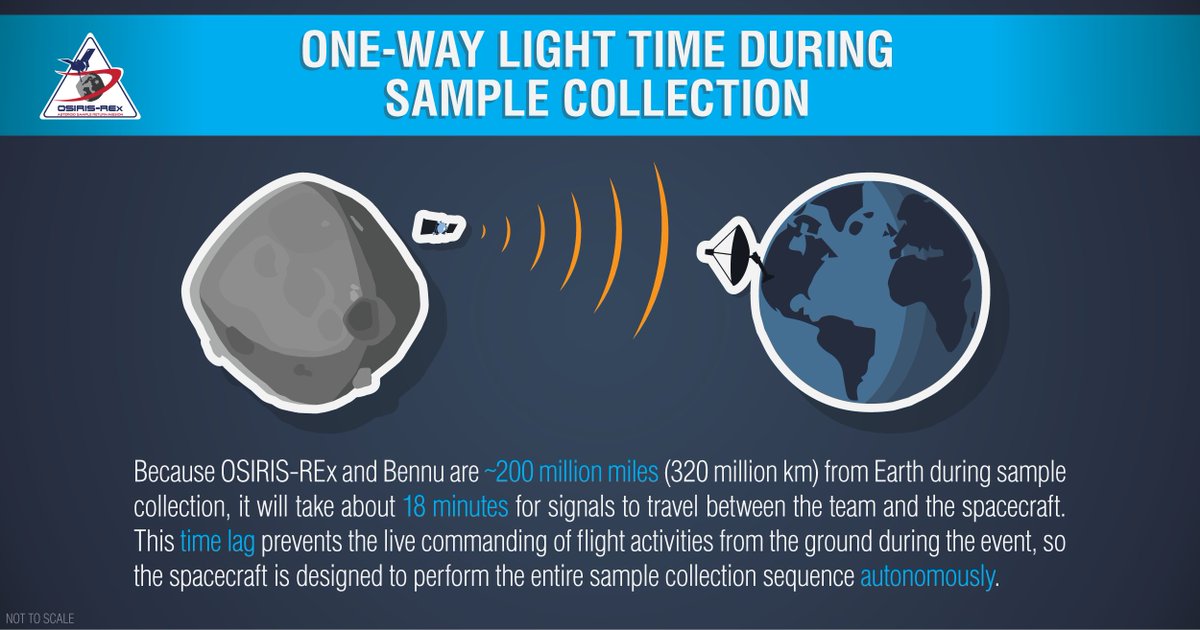
This account is no longer active. Follow @NASASolarSystem for the latest on NASA's OSIRIS-REx Mission #ToBennuAndBack.
How to get URL link on X (Twitter) App


 My team has already given me everything I need for today's sample collection event! The final commands for today's activities were uplinked to me on Monday morning, and I received the official GO command this morning.
My team has already given me everything I need for today's sample collection event! The final commands for today's activities were uplinked to me on Monday morning, and I received the official GO command this morning.

 The collector head is very flexible, and is connected via a hinge-like design so that it can tilt with Bennu's surface. It's also pretty small, measuring 12 inches (30 cm) in diameter - a bit bigger than a dinner plate! 🍽
The collector head is very flexible, and is connected via a hinge-like design so that it can tilt with Bennu's surface. It's also pretty small, measuring 12 inches (30 cm) in diameter - a bit bigger than a dinner plate! 🍽




 These boulders are located next to site Nightingale. Obviously they’re too big to pick up, but there are lots of other smaller rocks here that are sample worthy 👍
These boulders are located next to site Nightingale. Obviously they’re too big to pick up, but there are lots of other smaller rocks here that are sample worthy 👍




https://twitter.com/OSIRISREx/status/1224747143769935873

 The large boulder spine in Bennu’s southern hemisphere is now called Tlanuwa Regio. It’s named for the giant birds who scattered the Earth with pieces of a serpent that turned into standing pillars of rocks in Cherokee mythology.
The large boulder spine in Bennu’s southern hemisphere is now called Tlanuwa Regio. It’s named for the giant birds who scattered the Earth with pieces of a serpent that turned into standing pillars of rocks in Cherokee mythology. 

 Over the next few months, I’ll perform medium and low passes over sites Nightingale and Osprey — getting as close as 820 ft (250 m) to the surface 😱
Over the next few months, I’ll perform medium and low passes over sites Nightingale and Osprey — getting as close as 820 ft (250 m) to the surface 😱

 Some of the material in one of these images will be coming back to Earth 😱
Some of the material in one of these images will be coming back to Earth 😱 

 Diane Lambert from @uarizona, Jason Leonard, and Daniel Wibben from @KinetXSNAFD were all awarded an Exceptional Engineering Achievement Medal
Diane Lambert from @uarizona, Jason Leonard, and Daniel Wibben from @KinetXSNAFD were all awarded an Exceptional Engineering Achievement Medal
 Nightingale, which lies within the white circle, covers roughly 6 parking spaces. Sampling regions in this site range from 16 ft (5 m) to 33 ft (10 m) in radius.
Nightingale, which lies within the white circle, covers roughly 6 parking spaces. Sampling regions in this site range from 16 ft (5 m) to 33 ft (10 m) in radius. 

 Located in Bennu’s far north, Nightingale is set in a large crater that is 459 ft (140 m) in diameter. Nightingale contains mostly fine-grained, dark material and has the lowest albedo and surface temperature of the four sites.
Located in Bennu’s far north, Nightingale is set in a large crater that is 459 ft (140 m) in diameter. Nightingale contains mostly fine-grained, dark material and has the lowest albedo and surface temperature of the four sites.

 Look at the *height* on that rock circled in red. The shadows from the image on the right suggest that there is some elevation (even though it looks relatively flat), but if you really want to understand the terrain, there’s no substitute for having a bunch of viewing angles.
Look at the *height* on that rock circled in red. The shadows from the image on the right suggest that there is some elevation (even though it looks relatively flat), but if you really want to understand the terrain, there’s no substitute for having a bunch of viewing angles. 

 This boulder is pretty recognizable because of that light-colored rock laying on it. The rock is 6.2 ft (1.9 m) long -- about the same height as a person.
This boulder is pretty recognizable because of that light-colored rock laying on it. The rock is 6.2 ft (1.9 m) long -- about the same height as a person.
 Before my braking maneuver this morning, I was cruising along at about 1,099 miles per hour (491 m/sec) relative to Bennu. At that clip, I could have traveled from New York to Miami in an hour. ⏱ #WeBrakeForAsteroids
Before my braking maneuver this morning, I was cruising along at about 1,099 miles per hour (491 m/sec) relative to Bennu. At that clip, I could have traveled from New York to Miami in an hour. ⏱ #WeBrakeForAsteroids 